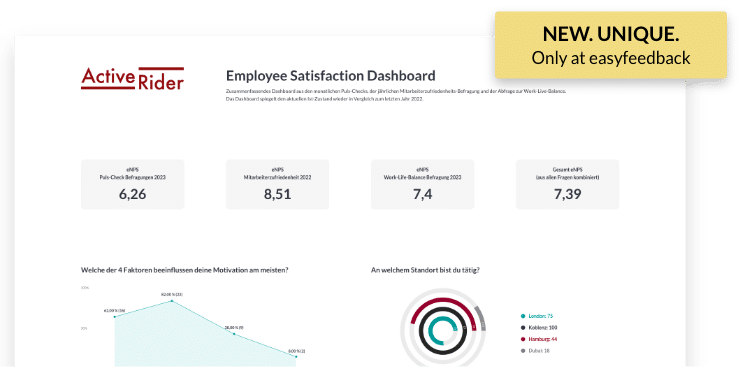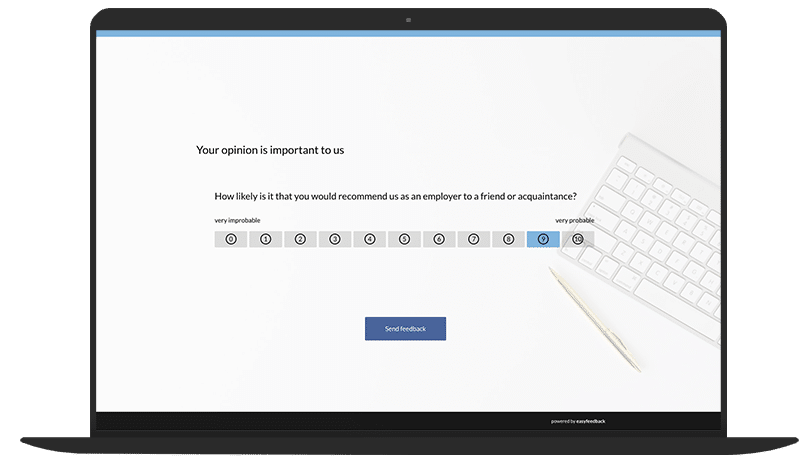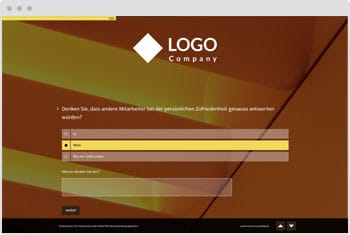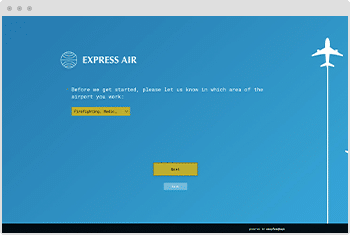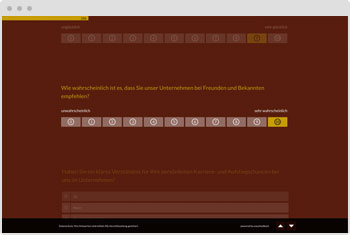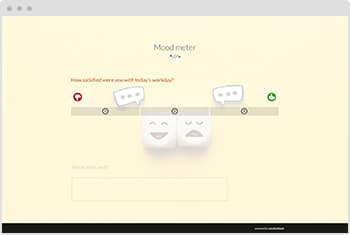Measuring employee retention with the Employee Net Promotor Score

With this ready-made survey template you can easily measure your employees' satisfaction and loyalty with your company with just one question. Try it out!

“Identifying customer needs is an essential part of our business. easyfeedback accompanies us for many years as a loyal partner in this task. We particularly appreciate the intuitive usability of the survey tool as well as the professional support.“
Guild Lead User Experience Research
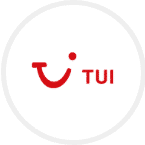
“We use easyfeedback for internal and external surveys – fast, comfortable and really easy! Straightforward and cordial support can always create a smile. We really appreciate the permanent development of the platform.“
Guest & Competitor Insights Analyst
Content and targets of this eNPS template
How loyal are your employees to you? Do you know?
According to the Gallup Engagement Index of 2020 , 68% of employees for example in Germany have only a low emotional attachment to their employer. 15 % even stated that they had no emotional attachment to their employer at all.
In the USA, too, employers have problems with employee satisfaction and retention. More than a third of workers are searching actively or casually for a job . As a result, US employers spend $2.9M per day looking for replacement workers. That’s $1.1B per year.
These figures are alarming information for employers all over the world. In times of a shortage of skilled workers, the loyalty of an employee to the company is more important than ever, because finding good employees is difficult.
If you want to actively improve employee retention in your company, the first thing you have to do is find out how satisfied employees currently are with their working conditions or work-life balance, for example.
After all, overall satisfaction is ultimately a decisive factor in whether employees stay for the long term or look for a new employer.
To avoid having to design and conduct lengthy surveys to measure employee loyalty, the Employee Net Promoter Score (eNPS) has proven to be a valuable metric. With just one question and the average value of all answers given, good statements can already be made about employee satisfaction and loyalty.
You too can use the eNPS in your company to easily measure employee loyalty, to derive measures and to reduce employee fluctuation.
Content:
• Asking for willingness to recommend
• Measuring employee satisfaction with key figures
• Identify employee wants & needs
Goals:
• Determine employee satisfaction
• Measure employee loyalty
• Identify trends
• Strengthen employee loyalty
• Prevent fluctuation with employee feedback

Data privacy protection „made in Germany“ (GDPR)

Anonymity functions for open feedback
Almost everything you need to know about eNPS
1. What is the eNPS?
The Employee Net Promotor Score is a key figure that allows you to easily find out how loyal and connected employees are to your company. To do this, you simply ask employees how likely they are to recommend their company to friends or acquaintances on a scale of 0 – 10.
At the end, the results of the eNPS survey can be used to calculate an average value that provides information about how loyal employees are to your company. This information enables you to make more in-depth analyses, derive measures, and thus increase employee satisfaction and retention in your company.
2. Why take an eNPS survey?
There are different reasons why companies should measure employee retention.
On the one hand, because it is difficult to find good staff in times of a shortage of skilled workers. For another, to avoid losing good employees due to dissatisfaction. Likewise, conducting the eNPS survey can make sense to increase the motivation of your employees, as motivated and loyal workers are more productive than unmotivated ones.
Regardless of the reason for collecting the Employee Net Promoter Score, it shows at a glance how employee retention is currently doing in your company. On the other hand, it provides a basis for monitoring development and trends over time.
3. Advantages of the Employee Net Promotor Score?
The biggest advantage of the eNPS is its simplicity. By simply asking employees how likely they are to recommend your company to others, you don’t need a lot of preparation time, and you get a single number as a metric that is super easy to work with. From this key figure, statements can be made very quickly about how your company is doing in terms of employee satisfaction and loyalty.
This means that the key figure can serve as a kind of basis for carrying out more in-depth analyses if required. It is also possible to identify trends and developments in employee satisfaction using different survey dates.
Furthermore, due to its short survey duration, the eNPS has a higher response rate than conventional surveys and is also a financially cost-effective method.
The advantages are summarized here once again:
- fast and easily measurable method
- high participation rates due to very short survey duration
- provides information about development and trends in employee satisfaction
- basis for more in-depth analyses
- little preparation time required
- cost-effective method
4. How is the eNPS calculated?
Calculating the Employee Net Promotor Score is not complicated, but it does require a brief explanation.
In the eNPS, employees answer the question about the likelihood of recommending your company as an employer on a scale of 0 – 10. The higher the number given by the employee, the higher the likelihood that the employee will recommend your company.
If the employee gives you a rating of 9 or 10, he is a supporter (also called a promoter) of your company. This means he is satisfied with you as an employer and has a high emotional connection with your company.
If the employee gives a rating of 7 or 8, he is neutral towards your company. He is satisfied with you as an employer, but would not recommend you to others.
If the employee only gives you a rating of 6 or less, he is a critic and is correspondingly less satisfied with you as an employer. Therefore, he will not recommend your company to others. It could also be that this employee is more likely to make negative comments about your company to friends and acquaintances or is thinking of leaving the company.
To calculate the eNPS, it is now important to first add up the total number of responses. Then one must calculate the percentage of people with the rating of 9 or 10 (supporters) and the percentage of ratings between 0 and 6 (critics).
Finally, subtract the percentage of detractors with the percentage of supporters. In the end, you have the Employee Net Promotor Score, which is between -100 and +100. The closer to +100, the better your company’s employee retention.
A quick example: You are a company with 100 employees. According to the eNPS survey, you have determined that there are 30 promoters among the employees, 40 neutrals and 30 detractors. Then the calculation to the Employee Net Promotor Score would look like this:
eNPS = 30 (promoters) – 30 (detractors) = 0.
5. What is a good eNPS score?
In general, we can state: The closer the eNPS score is to +100, the better. After all, this is the highest score that can be achieved in eNPS. But in practice, this value is almost impossible to achieve. Since all employees would have to rate the questions on the probability of recommendation with a 9 or 10. This can work for small companies, but it is more difficult for larger ones.
Therefore, the following applies: A value above 0 should be achieved in any case. All values below 0 should be considered an alarm signal. In this case, you should investigate the causes and take measures to increase employee satisfaction and loyalty.
6. Are there any tips on how to use the eNPS?
Yes, there are. Here are four tips on what to look for when using the eNPS survey:
1. Preserve anonymity
Employee surveys are often a sensitive topic in companies. Participants are reluctant to provide honest feedback for fear of negative consequences.
So if you want your employees to answer the question honestly, make participation in the eNPS survey anonymous. Communicate this to participants before the survey begins to eliminate any potential doubts and increase their participation rate.
2. Do not hide information
If you want to conduct the Employee Net Promotor Score survey, you are most likely to gain the trust of the workforce if you disclose all information about it transparently and comprehensively. Explain who is conducting the survey, what the survey is about, what the goal is, and how employees will benefit.
Provide a contact person and contact information for queries. You can already include this in the invitation to the eNPS survey or in the welcome text of the survey.
Be patient
Not every employee will have time to complete your survey right away. Wait a few days and then remind employees again to participate. Explain to them why it’s important to participate in the survey and the benefits to them. Practice patience, otherwise you will scare employees away and they will end up not participating in the survey at all.
4. Offer flexible ways to participate
Not every employee has an affinity for today’s technology. Some are good with a smartphone, for example, while others are less so. Others are in a home office and still others are in the company.
Therefore, offer your employees the opportunity to participate in the survey flexibly from different devices and different locations.
You are in professional company







easyfeedback welcomes more than 740.000 participants per month
